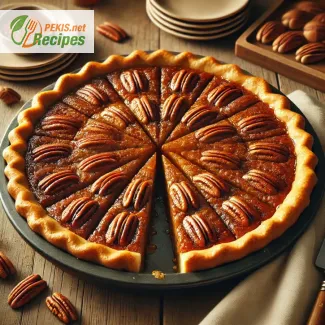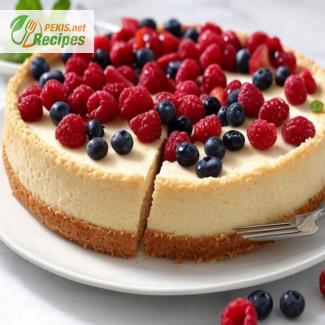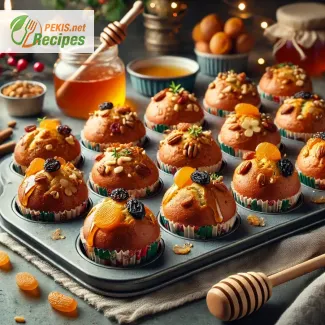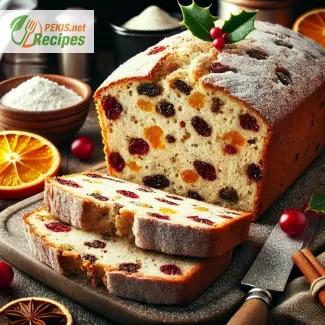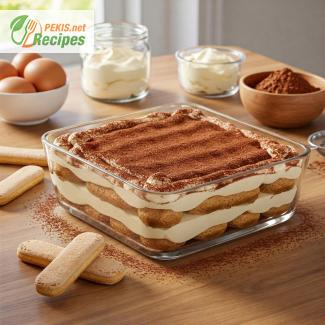
The Silky Elegance of Homemade Vanilla Cream
Discover the Irresistible Charm of Vanilla Pastry Cream
Smooth, rich, and delicately fragrant, vanilla pastry cream—known as crème pâtissière in French cuisine—is a cornerstone of classic desserts around the world. Whether it’s layered in a fruit tart, piped into éclairs, or nestled in the heart of a fluffy cream puff, vanilla cream offers an unmatched balance of sweetness, silkiness, and warmth. This beloved custard filling delivers not only a luxurious texture but also a nostalgic flavor that connects generations of bakers and dessert lovers.
This recipe for classic vanilla cream is a celebration of simplicity and elegance. With just a few essential ingredients—milk, sugar, egg yolks, and real vanilla—you can create a velvety base that elevates every dessert it touches. The aroma alone, wafting from the stovetop as the mixture thickens into a golden custard, is enough to transport you to your favorite patisserie.
From traditional European confections to modern homemade sweets, vanilla pastry cream has carved out its role as a versatile and indispensable component in baking. Its appeal lies in its adaptability: you can serve it warm or cold, use it as a filling, a layer, or even a standalone treat topped with fresh berries. It complements a variety of textures and flavors, making it the secret behind many decadent desserts.
What makes a homemade vanilla cream truly special is the use of quality ingredients and the gentle, loving attention to the cooking process. Unlike store-bought custards or powdered mixes, this version lets the natural sweetness of vanilla shine through without artificial flavorings. Each spoonful reveals layers of flavor—mellow, creamy, and luxuriously smooth.
As you master this recipe, you’ll find it becomes a go-to component in your baking repertoire. From Napoleons and Boston cream pies to mille-feuille and Danish pastries, this cream binds desserts together with elegance and taste. And yet, it’s easy enough to prepare on a quiet afternoon, a rewarding kitchen ritual that results in something magical.
While the foundation of vanilla cream is simple, achieving the perfect consistency and balance of flavor requires a thoughtful technique. Gentle whisking, precise heating, and quality ingredients are the keys to turning everyday components into a confection that feels like pure indulgence. It’s a reminder that in baking, as in life, the simplest things often bring the most joy.
So whether you're a seasoned baker or just starting your culinary journey, this classic vanilla pastry cream will give you the confidence to create desserts that are not only beautiful but also deeply satisfying. The richness of the custard, paired with the unmistakable aroma of natural vanilla, creates a sensory experience that turns any dessert into something extraordinary.
In the following recipe, you'll learn how to prepare this timeless cream from scratch using a foolproof method that delivers consistently silky, luscious results. Prepare to impress family and friends—or simply treat yourself to a spoonful of pure comfort. This is vanilla cream at its finest: smooth, aromatic, and undeniably delicious.
- Prepare the vanilla flavor: If using a vanilla bean, slice it lengthwise and scrape out the seeds. Add both seeds and pod to a saucepan with the milk.
- Heat the milk: In a medium saucepan, heat the milk over medium heat until just before boiling. Remove from heat and let the vanilla infuse for 5 minutes. Remove the pod if used.
- Whisk the egg mixture: In a separate bowl, whisk together the egg yolks and sugar until the mixture becomes pale and slightly thickened. Then whisk in the cornstarch until smooth and lump-free.
- Temper the eggs: Gradually pour a small amount of the hot milk into the egg mixture while whisking constantly. This will prevent the eggs from curdling. Once tempered, slowly whisk the rest of the milk into the bowl.
- Cook the cream: Pour the entire mixture back into the saucepan and return it to medium heat. Cook while whisking constantly until the mixture thickens and comes to a gentle boil. Keep whisking for another 1–2 minutes to eliminate any starch taste.
- Add butter: Remove from heat and stir in the butter until fully melted and incorporated. This adds richness and a glossy texture.
- Chill the cream: Pour the cream into a clean bowl. Press plastic wrap directly onto the surface to prevent a skin from forming. Let it cool at room temperature, then refrigerate for at least 2 hours before using.
Assembly tips:
Vanilla pastry cream can be used as a filling for éclairs, fruit tarts, cakes, mille-feuille, donuts, or Danish pastries. Before using, give it a quick stir or whisk to restore its creamy texture.
Elevating Your Vanilla Cream to a Gourmet Level
Smart Techniques and Ingredient Tweaks to Enhance Your Pastry Cream
Mastering a traditional vanilla cream recipe is a culinary triumph, but there’s always room to take it a step further. Whether you're aiming for deeper flavor, smoother texture, or healthier options, even subtle changes can yield big results. Understanding how each ingredient contributes to the final outcome gives you full control over the texture, taste, and overall quality of your pastry cream. Here’s how to enhance the recipe you already love and turn it into something truly exceptional.
Choosing the Right Vanilla: Bean vs. Extract vs. Paste
One of the simplest yet most powerful ways to upgrade your vanilla pastry cream is by using real vanilla bean instead of extract. The natural oils and tiny black seeds found inside the pod provide a deeper, more aromatic flavor that infuses the cream with complexity.
While pure vanilla extract is a convenient option, it often lacks the intensity and depth that fresh vanilla offers. A great middle ground is vanilla bean paste, which combines real seeds with a thick syrup base and delivers visual appeal along with bold flavor. Opting for high-quality vanilla dramatically improves the fragrance and elegance of the cream.
Boosting Richness with Cream or Dairy Alternatives
For an even silkier result, try replacing part of the milk with heavy cream. A 2:1 ratio of milk to cream gives the custard a richer mouthfeel without making it overly fatty. Alternatively, if you’re seeking a lighter version, whole milk alone suffices, while low-fat milk may compromise texture and flavor.
Those who follow a plant-based diet can use unsweetened almond milk or oat milk. Oat milk, in particular, mimics the creaminess of dairy and provides a pleasantly neutral taste that lets the vanilla shine.
Intensifying the Flavor with Additional Notes
To add a sophisticated twist, consider enhancing the base with a splash of dark rum, orange zest, or a pinch of tonka bean (use sparingly). These additions don’t overwhelm the vanilla, but rather add depth and warmth, making the pastry cream more memorable. For a floral note, lavender or rose water—in very small quantities—can also be infused into the milk.
Common Mistakes and How to Avoid Them
Even the best recipe can go wrong if not handled properly. Here are some of the most common errors when preparing vanilla cream, and how to prevent them:
- Overcooking the custard: Once the mixture thickens and reaches a gentle boil, remove it immediately. Cooking it too long can lead to curdling or a grainy texture.
- Not whisking enough: Continuous stirring is crucial to avoid lumps and ensure even thickening.
- Adding butter too late: Incorporate the butter while the custard is still hot so it melts completely and emulsifies smoothly.
- Skipping the straining step: For the smoothest texture, strain the cream through a fine-mesh sieve before chilling.
Healthier Substitutes for Guilt-Free Enjoyment
While traditional pastry cream is indulgent by nature, it can be made lighter without sacrificing satisfaction. Try these simple swaps:
- Use honey or maple syrup in place of refined sugar for natural sweetness and added depth of flavor.
- Reduce sugar quantity by 10–15%—the vanilla and egg yolks already provide richness.
- Use arrowroot powder instead of cornstarch for a cleaner, grain-free thickener with a silkier result.
- Choose lactose-free milk or plant-based milk to make the cream easier to digest and suitable for sensitive stomachs.
The Superiority of Homemade Vanilla Cream
Store-bought custards often contain stabilizers, artificial flavors, and unnecessary preservatives. Making vanilla cream from scratch allows you to control every ingredient, ensuring freshness and authenticity. The homemade version is not only more flavorful but also healthier and free from additives. Moreover, the act of preparing the cream from raw ingredients fosters a deeper appreciation for traditional culinary techniques.
Texture Control and Customization
Depending on how you plan to use the cream, you can adjust its consistency:
- For layering in cakes or filling choux pastries, keep it thick and sturdy by increasing cornstarch slightly or chilling it longer.
- For a pourable custard over desserts, reduce the cornstarch and whisk in a tablespoon of milk before serving.
- For a lighter mousse-style cream, fold in whipped cream once chilled, creating a crème légère that’s airy and elegant.
Proper Storage and Reusability
Always press plastic wrap directly onto the surface of the cream to avoid skin formation. Once chilled, vanilla cream keeps for up to 3 days in the fridge. Stir gently before using. It can also be frozen in small portions, although freezing may slightly affect the texture. To restore it, whisk vigorously after thawing.
Enhancing Presentation and Pairings
Use vanilla cream not just as a filling, but as a topping or accompaniment. It pairs beautifully with:
- Seasonal fruits like berries, pears, or plums
- Crispy puff pastry for a textural contrast
- Chocolate elements, which balance the creamy vanilla
- Spiced components like cinnamon or nutmeg for a festive twist
With just a few thoughtful adjustments, the humble vanilla pastry cream becomes a customizable base for a world of desserts. Whether you're aiming for a healthier option, a gourmet finish, or a unique flavor profile, each change you make contributes to a richer culinary experience. Embrace experimentation while respecting tradition—this is how classics evolve.
- Milk (lactose)
- Eggs
- Possible gluten contamination if cornstarch is not certified gluten-free
Substitution tips to remove allergens and gluten:
- Replace milk with unsweetened almond milk or oat milk for a dairy-free version.
- Use plant-based butter alternatives.
- Replace egg yolks with a cornstarch and plant-based milk blend (note: texture will be less rich).
- Ensure cornstarch is certified gluten-free to avoid contamination.
Vitamin A: 350 µg – supports healthy vision and immune system
Vitamin D: 1.2 µg – helps with calcium absorption and bone health
Calcium: 110 mg – contributes to bone and dental strength
Phosphorus: 90 mg – essential for energy metabolism and bone maintenance
Iron: 0.4 mg – necessary for oxygen transport in the blood
Potassium: 130 mg – supports nerve function and muscle contraction
Vanillin (from natural vanilla): ~10 mg – may reduce inflammation and protect cells from oxidative stress
Lutein + Zeaxanthin (from egg yolks): ~180 µg – supports eye health and protects against free radical damage
Selenium (from eggs): ~7 µg – helps protect cells and supports immune function
Recipes worth trying
There’s nothing quite as comforting as the aroma of a freshly baked pecan pie wafting through your home during the holidays. This classic dessert is a staple on festive tables, loved for its rich…
If you're searching for a dessert that’s equal parts decadent and effortless, the no-bake cheesecake is a perfect choice. This creamy and velvety treat brings together the richness of cream cheese…
As the festive season approaches, St. Nicholas cookies hold a special place in kitchens and hearts across Europe. These delightful treats, known as Miklavževi piškoti in Slovenia, are more than…
Christmas Mini Breads with Honey and Dried Fruit are a delightful addition to any holiday table, encapsulating the warmth, sweetness, and nostalgia of the festive season. Baked in a muffin tin for…
As the holiday season approaches, the comforting aroma of freshly baked bread fills kitchens around the world, becoming a symbol of togetherness and indulgence. For those embracing a gluten-free…
A timeless Italian dessert to impress every time
Discover the elegance and simplicity of traditional tiramisuThere are few desserts in the world that can evoke the same sense of luxury,…
